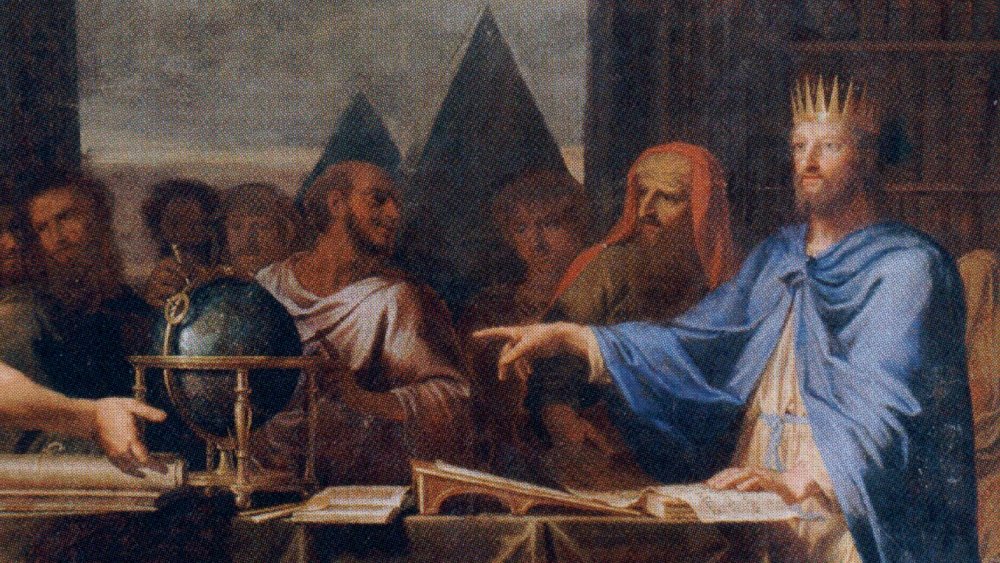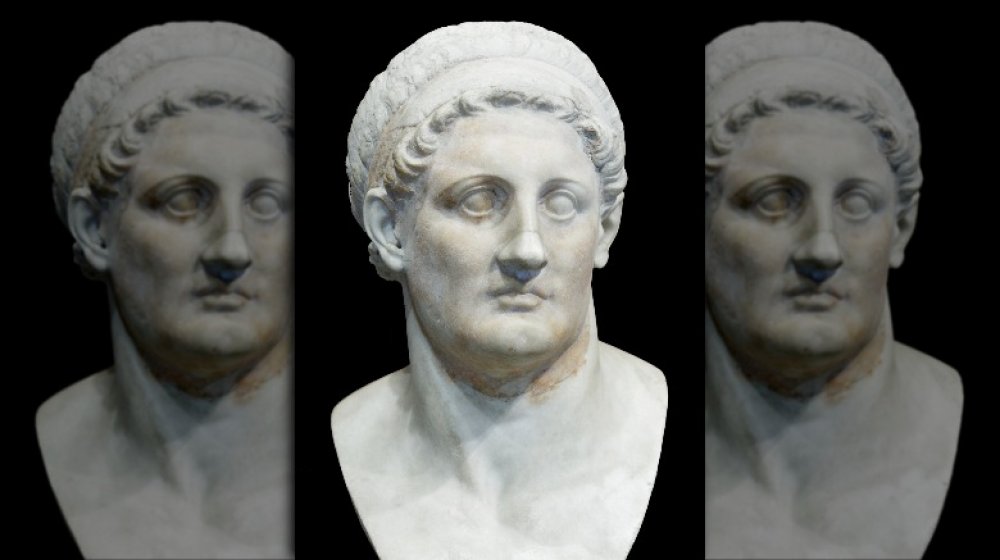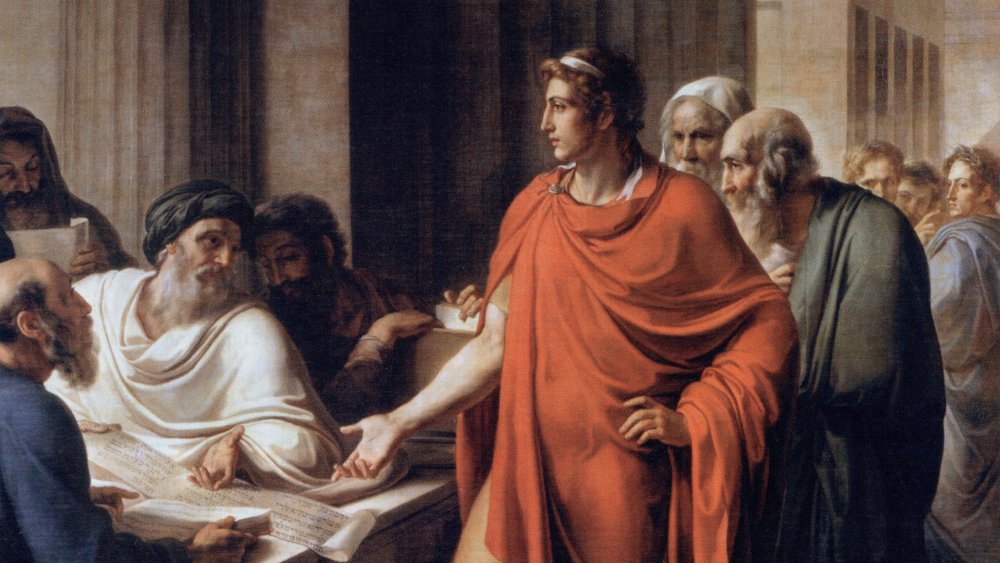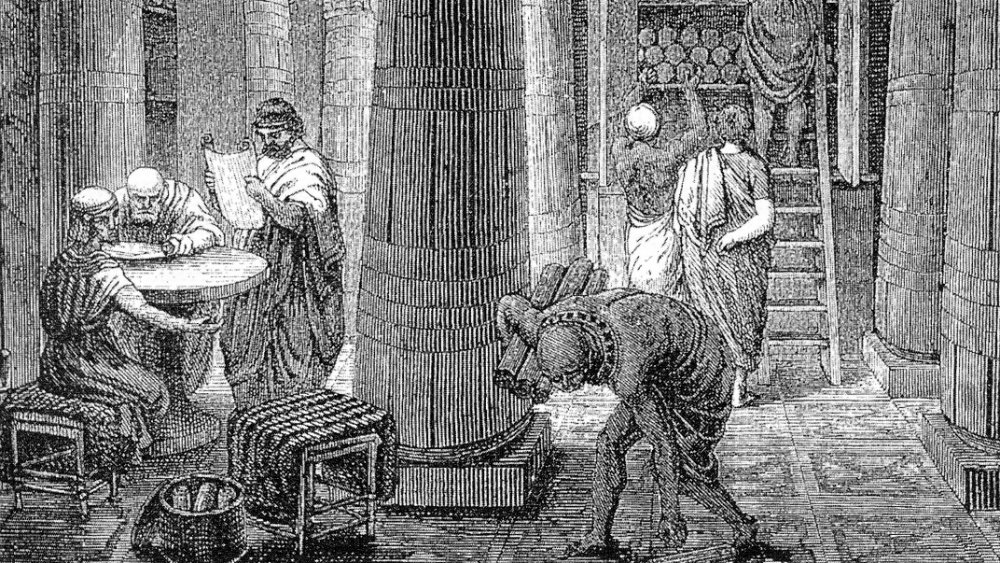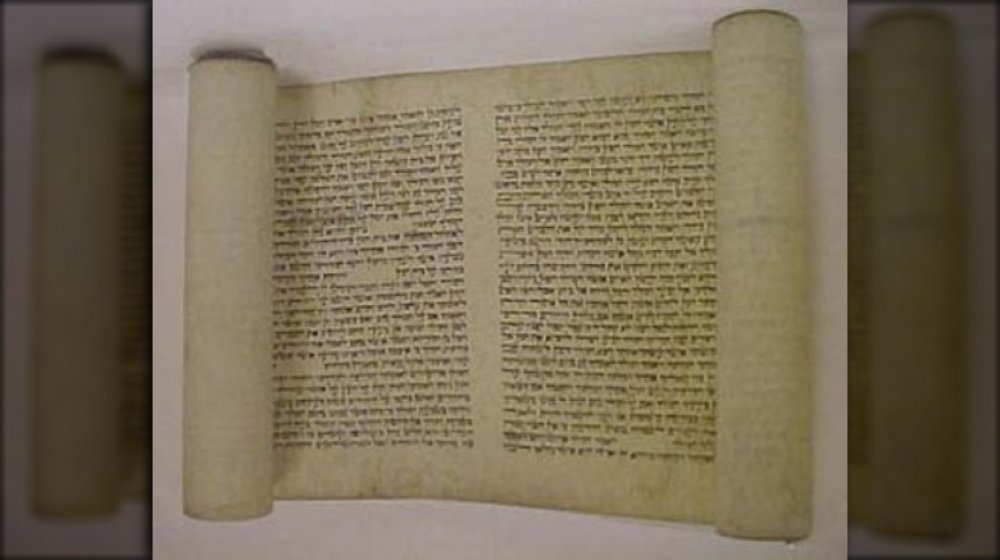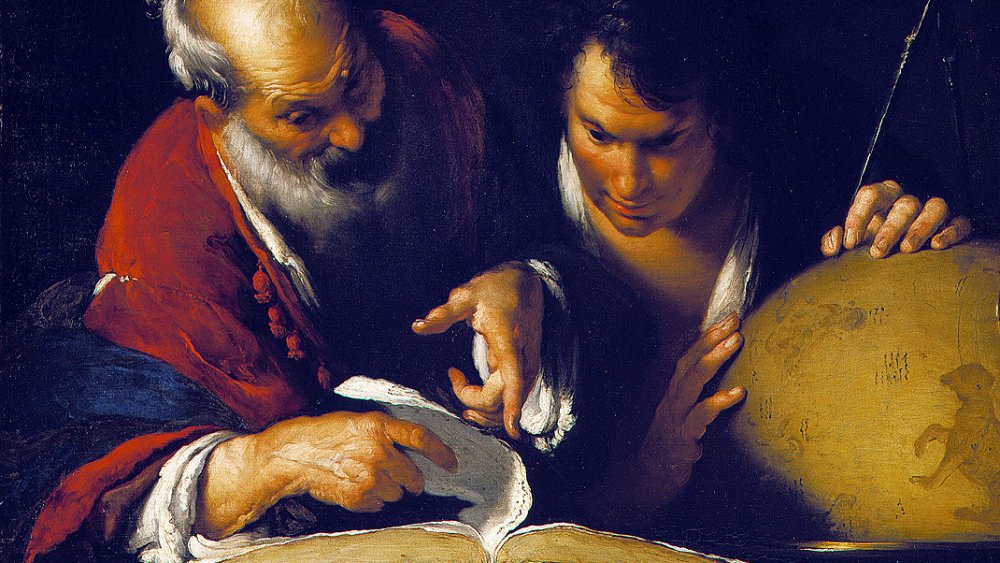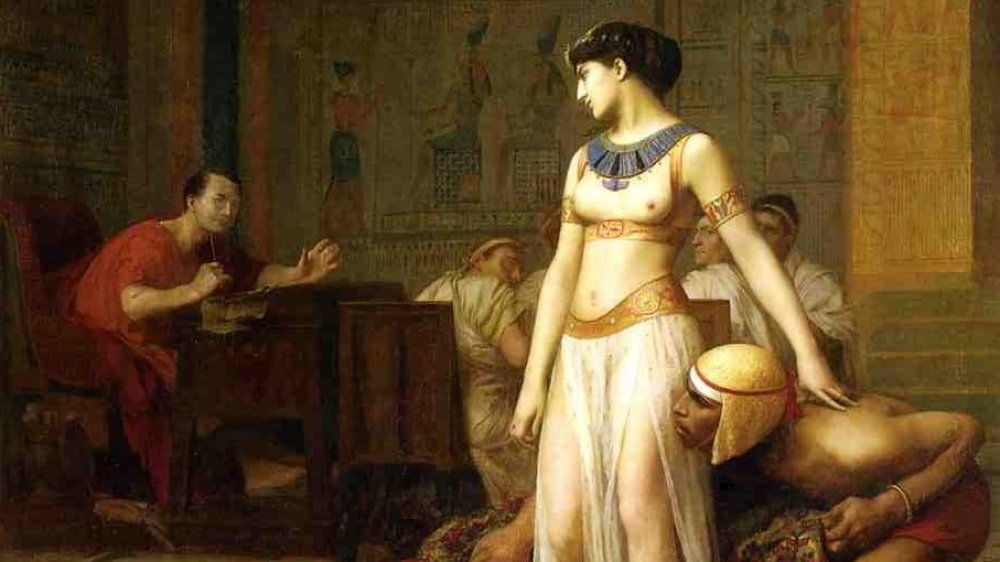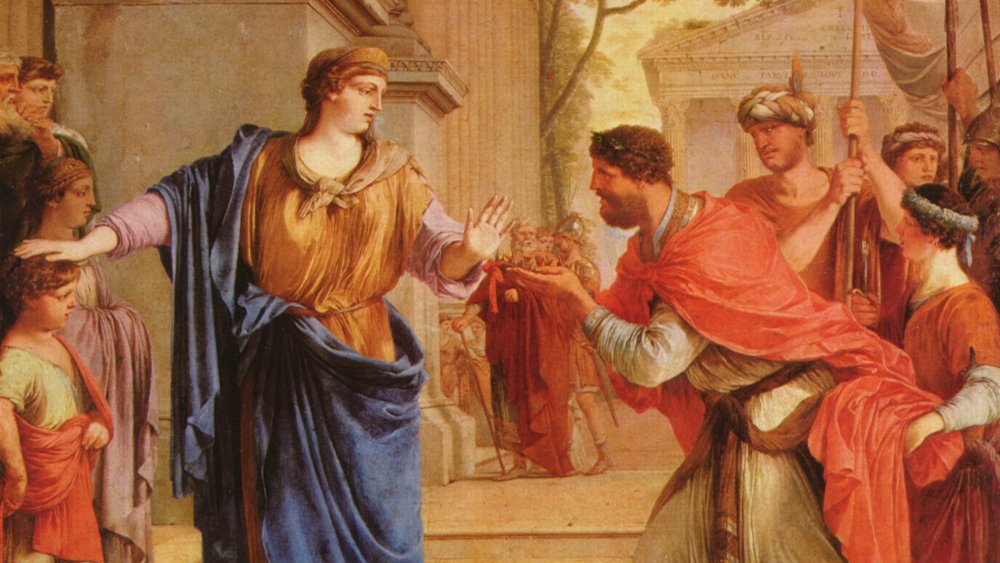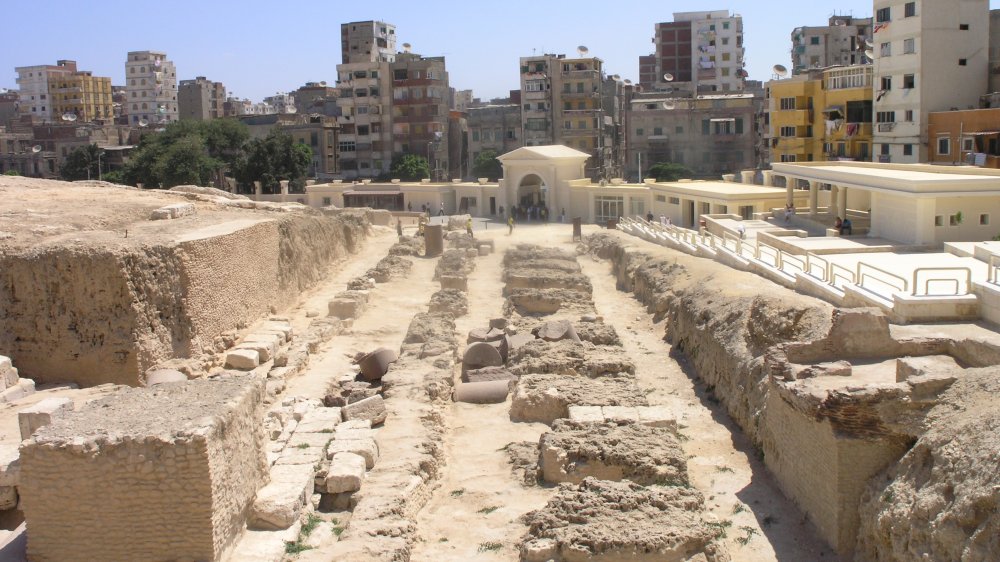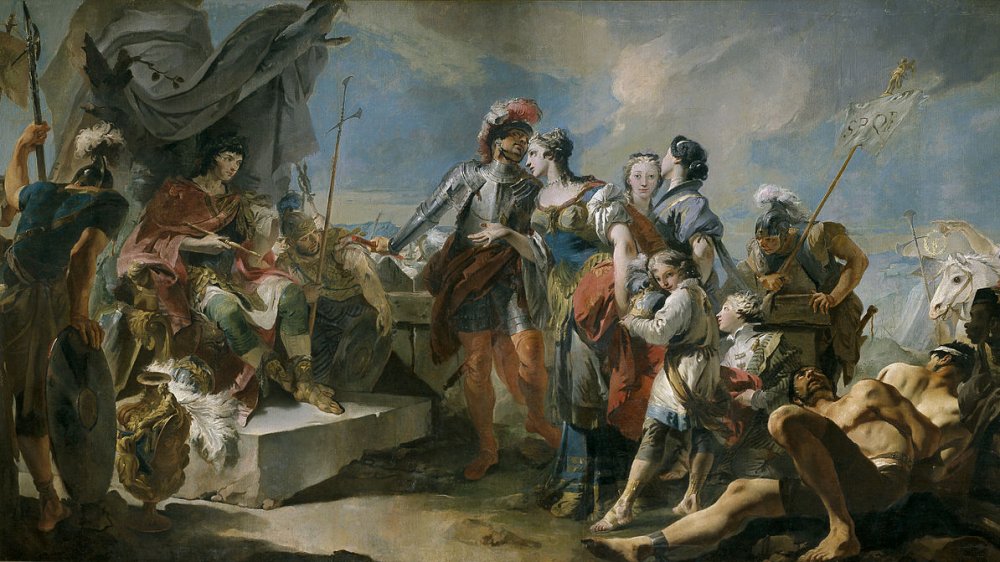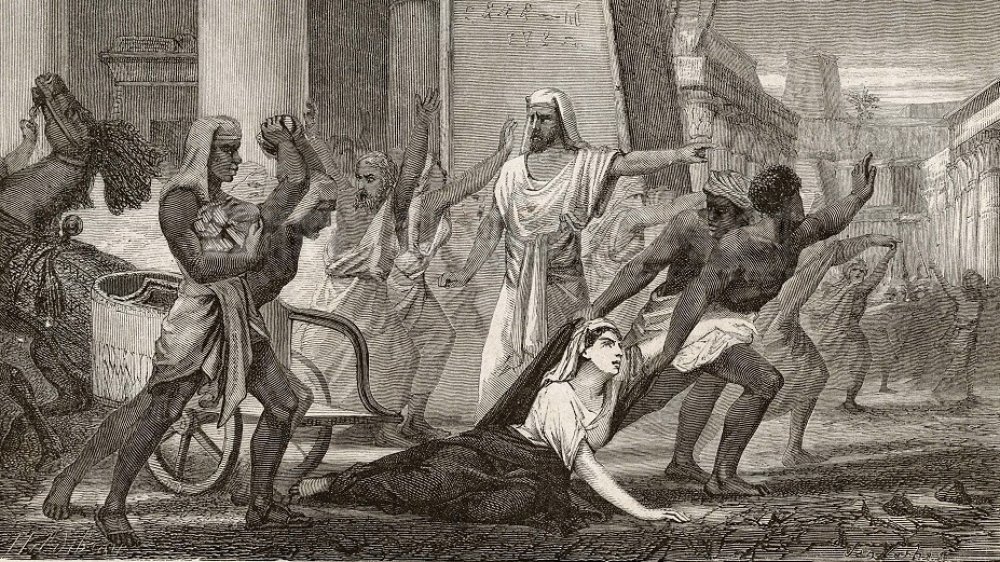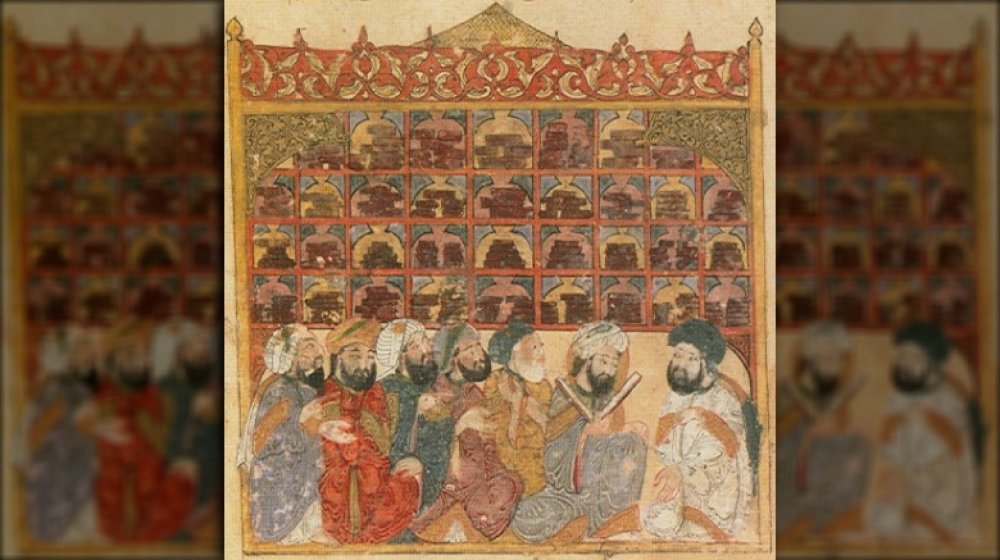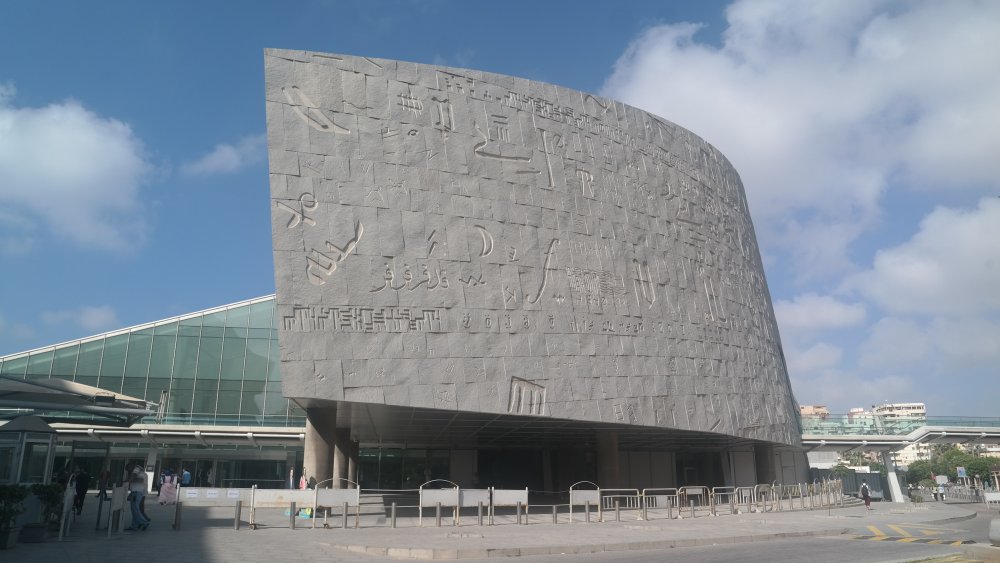The Tragic Real-Life Story Of The Library Of Alexandria
Though not literally one of the Seven Wonders of the Ancient World–that honor went to a nearby lighthouse–the Royal Library of Alexandria was, in fact, a wonder of the ancient world. Conceived in the Hellenistic, cosmopolitan spirit of Alexander the Great, the Library of Alexandria was built by Alexander's successors to be a central location for all information worth knowing. With this lofty goal in mind, the library became a hub for learning around the Mediterranean, and many of the Classical world's greatest minds flocked to it.
Nevertheless, tragedy struck the Great Library and all its invaluable manuscripts were lost. But how could such a thing happen? Who would want to bring ruin to a temple dedicated to learning and the arts unlike any before or since? The answer, it turns out, is more complicated than you might think. Read on for the tragic fate of the Library of Alexandria.
Laying the foundation of the Library
While there is no definitive information on who exactly conceived the idea for the construction of the Library of Alexandria, the spirit of insatiable curiosity behind it doubtlessly started with Alexander the Great, the Mesopotamian conqueror who spread Greek culture around the known world. As the Encyclopedia Britannica explains, libraries existed before the Alexandrian library, but they tended to be local affairs concerned primarily with conserving regional culture and literature. But Alexander's spirit of exploration and thirst for knowledge about the places he conquered infected the zeitgeist of the Hellenistic world that sprung up as a result of his accomplishments.
Alexander's successor as ruler in Egypt, Ptolemy I, is almost certainly the one who took the initiative to conceive the idea of a library containing all human knowledge in order to fulfill Alexander's dream of Alexandria as the epicenter of scientific inquiry and learning in the Mediterranean world. Ptolemy was aided in this pursuit by Demetrius of Phaleron, an exiled Greek philosopher who was given the unenviable task of creating a library that contained a copy of every book on Earth sometime around the year 295 BCE. According to the Greek bishop Irenaeus, Ptolemy wanted to fill "his library with the writings of all men as far as they were worth serious attention." We'll never know if he actually succeeded, but sure, let's say he did. You can't prove he didn't.
Construction begins
Demetrius of Phaleron convinced Ptolemy I to construct the Library of Alexandria as part of a larger temple complex known as the Mouseion, or Temple to the Muses. This temple was both a shrine to the nine goddesses of the arts and learning and also a cultural center for philosophical and intellectual lecture and debate. The name Mouseion is the source of the modern word museum, which continues to be the name for centers devoted to the arts and learning. According to the Ancient History Encyclopedia, the construction of the Mouseion began during the reign of Ptolemy I under the direction of Demetrius, and contained "lecture areas, laboratories, observatories, botanical gardens, a zoo, living quarters, and dining halls." However, the Library itself may not have come into being under Ptolemy I.
The earliest source we have on the Library is a document known as the Letter of Aristeas, which says that the Library was actually built by Ptolemy II, under the direction of Demetrius. However, the Letter is a work of Jewish pseudo-history disguised as correspondence between Greek brothers, and its testimony should be taken with a big pinch of salt. For example, we know that Ptolemy II actually had Demetrius executed for supporting his rival, so they probably didn't do a library team-up. That said, the Great Library most likely did begin construction during the reign of the second Ptolemy, sometime between 282 BCE and 246 BCE.
The less than scrupulous hunt for books
Gathering up a copy of every book worth a darn on the planet was no small task. As such, the librarians of the Great Library of Alexandria were known to use a number of fairly ruthless tactics to get the job done. According to the Encyclopedia Britannica, quite a bit of strong-arming was involved. One method for obtaining books involved men being stationed at the harbor of Alexandria whose job was to search every ship that came in and look for books. If they came across any, the books were confiscated, taken back to the library, and copies were made on the spot. The original owners would be given the copy and a sum of money as compensation, and the librarian would add the original to the Alexandrian stacks. Such books were referred to as "from the ships."
Another tale says that Ptolemy III wrote to the governors of Athens to ask for the loan of the complete works of the great tragic poets. These works were kept in the state treasury and were not available for lending. Ptolemy, however, said that he merely wanted to borrow them to make copies and that he would put down a deposit of 15 talents of silver as a security on the loan. The Athenians said okay, and once Ptolemy had the books, he told them to keep the money and sent the copies back to Athens.
Just how many books did the Library of Alexandria have?
It's probably safe to assume that the Library of Alexandria did not literally have every book in the world, even if we reduce the scope to the world known to Europeans in the third century BCE. So how many books did it actually have? BookRiot says that sources indicate that the Great Library housed between 500,000 and 700,000 books, organized into the subjects of rhetoric, law, epic, tragedy, comedy, lyric poetry, history, medicine, mathematics, natural science, and miscellaneous. The Ancient History Encyclopedia suggests that 500,000 books is too large an estimation and that that figure may refer to the number of scrolls, rather than the number of books, many of which would have been made up of multiple scrolls. At any rate, they had enough books that they built a second branch known as the Serapeum, as it was in the district of the temple of Serapis.
Which books did they have? They had an enormous collection of Greek documents acquired from Athens and Rhodes–including, allegedly, the private library of Aristotle himself–but they also translated numerous works from Egypt, Assyria, and Persia, and even Buddhist texts. One notable work they had that you might have heard of is called the Bible. The translation of the Hebrew scriptures into a Greek version called the Septuagint made for the Library is the core idea of the Letter of Aristeas.
Who's who at the Library of Alexandria
One reason you would even want to build the world's best library, besides the general prestige of it, is that you want to attract the world's best scholars, writers, and artists to come live and work in your city. The Library of Alexandria, by all accounts, succeeded mightily in that goal. ThoughtCo. relates a number of the more famous patrons and in-house scholars of the Great Library, including the great mathematician Euclid. If you've ever studied geometry, you have that guy to thank, as the concepts of his seminal work Elements are still taught today. Additionally, the astronomer Ptolemy (not to be confused with the long string of Ptolemies who ruled Egypt) worked in Alexandria, where he developed a model of the universe that was the standard model until Copernicus, over 1,000 years later.
Another notable Alexandrian scholar–and indeed, its third head librarian–was Eratosthenes, who, nearly 2,000 years before Christopher Columbus, proved that the Earth was round just by measuring shadows. He also calculated the Earth's circumferences to a shockingly accurate degree. Great poets also lurked among the Alexandrian stacks, including Callimachus, who in addition to being one of the most significant pastoral poets of the Hellenistic era also invented the first library catalog in his work Pinakes ("Tables"). Apollonius of Rhodes, who wrote an epic poem about Jason and the Argonauts that changed the epic genre for a new era, was Callimachus' student in Alexandria.
Did Caesar really burn the Great Library?
The reason we have to speculate on so many aspects regarding the Library of Alexandria, such as how many books it contained and what it looked like, is that the library and its contents were completely destroyed at some point in the distant past. This loss of the most complete collection of ancient literature ever assembled is a major catastrophe–arguably one of the greatest in history–but we're actually not even 100 percent sure how the catastrophe itself happened. As the Ancient History Encyclopedia explains, the destruction of the Great Library probably didn't happen the way many people think it did, or at least not at the same scale.
The most common understanding of the destruction of the library was that it was burned in 48 BCE when the city of Alexandria was occupied by Julius Caesar. The story goes that Caesar found himself trapped in the royal palace with Egyptian ships blocking any potential exit via the harbor. Caesar ordered his men to burn the Egyptian ships to enable his escape, but the fire got out of control and burned not only the ships, but also numerous buildings on the nearby shore, including storehouses and arsenals. While even in Roman times this was thought to include the Great Library, evidence suggests that part or even all of the library survived Caesar's fire, only to be destroyed later.
Driving all the scholars out of Alexandria
While the fire caused by Caesar's campaign in Alexandria is often blamed for the destruction of the Great Library, the fact is that the institution had been in decline long before the Romans got there. According to author E. R. Bevan, during the reign of Ptolemy VIII (yes, another Ptolemy; it's Ptolemies all the way down)–whose official title was Euergetes, meaning "benefactor," but who was more popularly known as Physcon, "the pot-bellied"–the scholars of the library got in the middle of a dynastic struggle that meant trouble for the fabled institution. In 145 BCE, the library's head librarian, Aristarchus, as well as most of the intellectuals of Alexandria, cast their support behind Ptolemy VII (known as Philopator) over his rival Physcon, known as something of a monstrous brute.
Proving that assessment accurate, Physcon murdered Philopator and took the throne, after which his first order of business was to purge the city of anyone he thought to have been sympathetic to Philopator. This included Aristarchus and all of Alexandria's intellectual elite, who scattered throughout Greece and its colonies to escape the vengeful hand of Physcon. Aristarchus himself fled to the island of Cyprus, where he intentionally starved himself to death. This diaspora of scholarship was beneficial for the Greeks lands to which the scholars fled, but it meant that many artists and intellectuals of Alexandria no longer wanted to associate with the library.
Destruction of the daughter branch
Despite the decline in the Library of Alexandria's scholarly cachet due to warring Ptolemies and the fire in the city caused by Caesar's troops, evidence seems to suggest that at least part of the library was still standing decades after Caesar had been there. As the Ancient History Encyclopedia explains, the philosopher Strabo worked in Alexandria in 20 BCE, and while he makes it clear that the library did not have the prestige it once did by not mentioning the library specifically, he does talk about visiting the Mouseion and its various facilities. If the Mouseion was still around in 20 BCE, obviously Caesar didn't destroy it in 48 BCE. For better or worse, we do have record of a Caesar actually destroying part of the library, but it's much later than Julius.
By 391 CE, Rome had become a Christian empire and its emperor, Theodosius I, wanted to wipe out all vestiges of paganism throughout all of Rome's territories. This included the Serapeum, the daughter branch of the Library of Alexandria that doubled as a temple to Serapis. We know that the Serapeum, located near the Great Library, was destroyed by Theophilus, the Bishop of Alexandria, but we have no way of knowing whether the Mouseion and the Great Library still existed at this time, but some scholars have hypothesized that its final destruction, too, occurred at this time.
Finishing the job Caesar started
As the Ancient History Encyclopedia points out, trying to single out one individual incident as being responsible for the destruction of the Library of Alexandria is essentially impossible. The city of Alexandria, as the namesake city of one of the greatest conquerors the world has ever known, was a hotspot for power grabs for much of ancient history, particularly during the Roman era. Besides various Ptolemies duking it out, there were rivalries between Roman leading men, and then rebellions by those oppressed by the Roman empire. As such, Alexandria's history was often extremely volatile, and the violence enacted upon the city had negative consequences for the library.
For example, the struggle between the Roman emperor Aurelian and the warrior queen Zenobia of Palmyra in 270 CE saw the city occupied by Zenobia's forces. Aurelian managed to recover the city for Rome after a violent and destructive battle, but not before much of the city had been laid waste. Specifically, the district in which the Great Library was located was said to have been "made into a desert." The city was subsequently sacked again a few years later by Diocletian. So who really destroyed the Library of Alexandria? Ptolemy VIII? Julius Caesar? Aurelian? Diocletian? Theodosius? The answer is kind of all of them. The great "catastrophe" that destroyed the marvelous Library of Alexandria was actually a gradual decline that took place over some 500 years.
The last Librarian of Alexandria
The Library of Alexandria enjoyed a number of extremely notable scholars as its head librarian over the centuries. There was a hugely influential epic poet, the man who measured the world, a man said to have memorized every book in the collection, and a grammarian believed to have been the greatest scholar in the entirety of antiquity. The very last head librarian, however, was Theon of Alexandria, about whom we know very little, but whose daughter is pretty famous. According to the Ancient History Encyclopedia, Theon was a mathematician and astronomer who lived in the back half of the fourth century CE. He lived during the reign of Theodosius (yes, the one who destroyed the Serapeum) and taught at the Mouseion. He observed and recorded two eclipses while at the Mouseion, and it is largely through his preservation work that we still have the works of Euclid today.
While that's about all we know about Theon, his daughter Hypatia is somewhat better known. Hypatia was a philosopher and mathematician born sometime around 370 CE, and she is basically the only female philosopher still known from Greco-Roman antiquity. While Hypatia was a respected teacher and philosopher in Alexandria, she was murdered in 415 CE by a mob of angry Christians due to her friendship with a local pagan prefect (and, naturally, because she was a witch). Her school, and the Mouseion, died with her.
One final theory
One last suspect in the destruction comes somewhat later than even the death of Hypatia. Ancient Origins records an account which states that the Muslim Caliph Omar was responsible for the final destruction of the library. In 640 CE, the Arab army under the control of General Amr ibn el-As managed to capture the city of Alexandria after an extended siege. The victorious Arabs had heard rumors of a marvelous library that contained all of the world's knowledge in it, and so Amr wrote to the Caliph for instructions on how to proceed. The caliph was not impressed with this fabled repository of all the world's books and so replied that if the books contained in the library agreed with the Quran, they were superfluous, and if they contradicted the Quran, they were heretical, and should be destroyed either way. Allegedly the scrolls were then gathered up and burned for fuel in the city's numerous bathhouses.
As punchy as this story may be, it is almost certainly apocryphal. For one thing, the written account of this event arises hundreds of years after it allegedly happened. Furthermore, there is exactly zero evidence that the Library of Alexandria existed in any form by the seventh century. Additionally, the author of the work was a Syrian Christian whose main motivation was likely to smear the name of the conquering Muslim caliph.
From the ashes, a new library
In Classical antiquity, Egypt was associated with a miraculous bird you might have heard of: the phoenix, who after a lifespan of 500 years or more builds a funeral pyre for itself and arises anew from its own ashes. Likewise, the Great Royal Library of Alexandria, though consumed by flames itself after centuries as a shining exemplar of scholarship and the arts, has risen again from the ashes to bring light to Egypt once again. According to the Encyclopedia Britannica, the idea for a revived Library of Alexandria inspired by the one built by the Ptolemies arose in 1972 from a professor at Alexandria University. The Egyptian government agreed to sponsor the project, and construction on the Bibliotheca Alexandrina was completed in 2001. The new site is next to the university and near to the location of the original Mouseion, just over 100 feet from the Mediterranean Sea.
The Bibliotheca is an architectural marvel, built as a giant cylinder emerging from the ground with a disc-shaped roof suggesting the shape of the sun rising over the sea. One of the walls is made up of over 6,000 granite panels containing letters and characters from all the world's known alphabets. The modern library houses over eight million volumes, far more than the ancient library could have ever hoped for, and also includes a planetarium and a school of library sciences.
